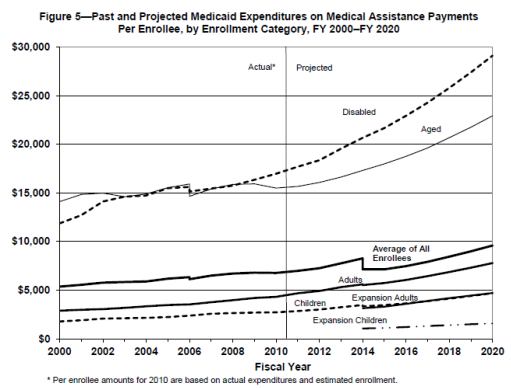More Uncertainty Regarding Medicaid Cost Estimates
In a post yesterday, we compared and contrasted estimates from the Congressional Budget Office and the Medicare actuary about who might enroll in the new Medicaid expansions in 2014. It’s also worth examining estimates of per-beneficiary spending by these newly covered individuals, which will depend in large part on whether those newly enrolled in Medicaid will be more or less healthy than the existing Medicaid population, and whether the new enrollees will engage in a burst of initial spending due to pent-up demand for unmet health needs.

To sum up, prior to last month’s Supreme Court ruling:
- CBO assumed at least 9.5 million newly eligible people would enroll in Medicaid; 7.5 million already eligible people would decide to enroll in Medicaid due to the law; and federal Medicaid spending would cost $6,000 in 2022
- The Medicare actuary assumed at least 21.2 million newly eligible people would enroll in Medicaid; 4.7 million already eligible people would decide to enroll in Medicaid due to the law; and total Medicaid spending (i.e., state and federal) would cost $5,000 per newly-enrolled adult and $2,000 per newly-enrolled child in 2020
We highlight these disparities to show the VAST degree of difference between the two sets of estimates – and therefore the large degree of uncertainty associated with the law’s impact. If 21.2 million newly eligible people enroll in Medicaid, as the Medicare actuary predicts, the predictions of the Congressional Budget Office – which thinks about half that number will enroll – about the law’s deficit neutrality would likely be shattered. Likewise, given the chart above, if adults in the expansion population incur expenses as great as adults in the existing Medicaid population, the law will increase the deficit by a significant amount.
The differences above demonstrate that the law’s supposed “deficit reduction” is far from a sure thing. In fact, given the things that must all fall into place for the law actually to live up to its fiscal hype, many may say that such assertions are highly dubious, and likely to be proven wrong.